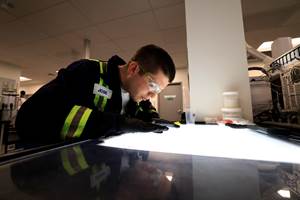Seven-Layer R&D Line Spurs Blown Film Innovation
Business might be slow in most blown film extrusion markets, but leading-edge processors are preparing for better times by tapping into a seven-layer line installed last year at Dow Chemical Co.’s Film Application Development Center (FADC) in Freeport, Tex.
Business might be slow in most blown film extrusion markets, but leading-edge processors are preparing for better times by tapping into a seven-layer line installed last year at Dow Chemical Co.’s Film Application Development Center (FADC) in Freeport, Tex. The line was part of Dow’s $5.2 million expansion of its FADC.
The line, furnished on a turnkey basis by Hosokawa Alpine American, Natick, Mass. (halpine.com), went up in February 2009. It was unveiled publicly during June’s NPE 2009 show in Chicago, when live demonstrations were shown on screens in Alpine’s booth.
Since the 2009 installation, Dow (plastics.dow.com) has had roughly 45 different customers in for more than 100 trials, says Greg Bunker, lead development specialist. “We’re not talking about a lab line here, but a full-scale production line that permits processors to produce commercial-grade film, allows them to experiment, to invent,” Bunker notes. Dow’s investment came during what has been perhaps the film industry’s worst economic slump ever. And it suggests that one way processors can emerge from it is to innovate.
“Customers who have come in to use the equipment run the gamut from those who are more familiar with monolayer production to ones with three-layer capacity who are looking to jump to more complex five- to seven-layer structures,” says Bunker. More than one processor has used the line for a short run of a brand-new film in order to “seed the market” with commercial-grade product to gauge customer reaction without occupying its own production equipment.
Confidentiality agreements preclude Dow from divulging who is making what on this line. “But we’re seeing things that have never been done before, both in the way of film structures and material combinations and penetration into new markets,” Bunker says.
The Alpine line has seven 50-mm, grooved-feed extruders with 30:1 L/D. It is equipped Alpine’s patented X die, which is designed to eliminate port lines. Dow has 200- and 250-mm die inserts. Bunker remarked on how quickly the die purges, which is critical where product changeovers are
the norm and setup time must minimized. Film gauge is regulated by Alpine’s segmented air ring. The line is also furnished with Alpine’s Resin Miser control system. Bunker says the fastest Dow has run the line is at 20 lb/in. of die circumference, though that is not the limit. Alpine says the line is rated at 1000 lb/hr.
Some of what Dow has run in Freeport are these structures:
- Four-mil-thick, three-layer structures for shipping sacks, the core of which is its high-melt-strength Inspire HMS PP.
- A 7-layer, 4-mil barrier film featuring Dow’s latest offering in the Dowlex LLDPE resin family, XUS 61530.04.
- Two-layer, 2-mil film for cookies, crackers, and other dry-food applications. The key material is Dow’s Elite 5960G enhanced PE.
- A 5-layer, 2.5 mil, high-clarity lamination sealant film for food packaging. Dow’s Elite 5940 provides clarity, stiffness and toughness to the film as the B component of the A/B/C/D structure.
- Three-layer, 4-mil stretch-hood film, run in an ABC formulation. A core layer of Dow’s Affinity polyolefin plastomer blended with Dow 1321 LDPE is sandwiched between a developmental Dowlex NG LLDPE grade, XUS 61530.02.
Related Content
First Quarter Looks Mostly Flat for Resin Prices
Temporary upward blips don't indicate any sustained movement in the near term.
Read MoreThe Fundamentals of Polyethylene – Part 1: The Basics
You would think we’d know all there is to know about a material that was commercialized 80 years ago. Not so for polyethylene. Let’s start by brushing up on the basics.
Read MoreNew Entrant Heartland Polymers Stepping up as Reliable Supplier
Heartland Polymers’ new Alberta, Canada facility will produce 525 KTA propylene and 525 KTA polypropylene. It is expected to stabilize supply chains across the continent.
Read MoreImproving Twin-Screw Compounding of Reinforced Polyolefins
Compounders face a number of processing challenges when incorporating a high loading of low-bulk-density mineral filler into polyolefins. Here are some possible solutions.
Read MoreRead Next
Advanced Recycling: Beyond Pyrolysis
Consumer-product brand owners increasingly see advanced chemical recycling as a necessary complement to mechanical recycling if they are to meet ambitious goals for a circular economy in the next decade. Dozens of technology providers are developing new technologies to overcome the limitations of existing pyrolysis methods and to commercialize various alternative approaches to chemical recycling of plastics.
Read MoreUnderstanding Melting in Single-Screw Extruders
You can better visualize the melting process by “flipping” the observation point so that the barrel appears to be turning clockwise around a stationary screw.
Read More
























